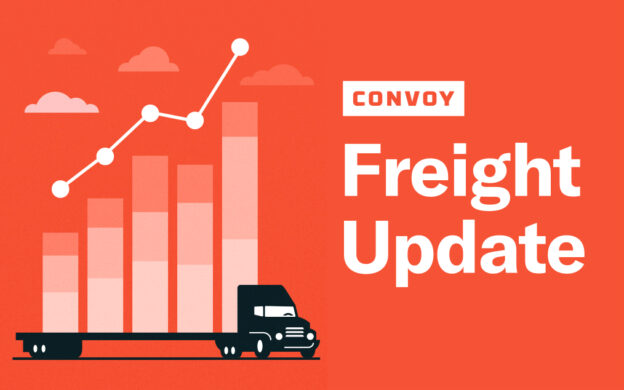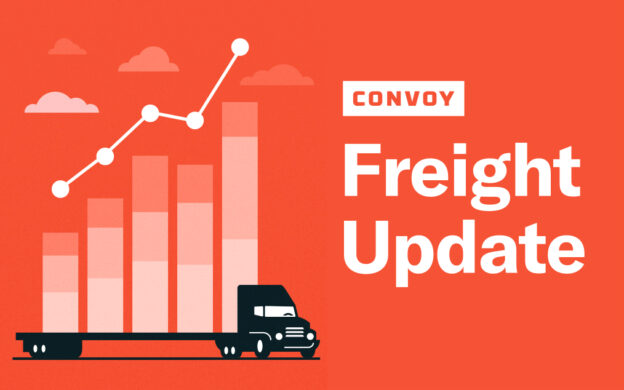Coronavirus and Freight: Market Outlook Video (March 26, 2020)
Freight Research • Published on March 26, 2020
This has been a rollercoaster of a week and it’s not even Friday. Financial markets recorded record losses on Monday, record gains on Tuesday, and another big increase on Wednesday. Will the proposals being considered in the nation’s capital be enough to sustain the economy while businesses are shuttered and states on lockdown?
Today we’re sharing the second of our twice weekly video series featuring Ari Bixhorn, our Head of Shipper Marketing and Aaron Terrazas, our Director of Economic Research. You can view the first video here:
Subscribe to Freight Economics Updates to get the latest developments delivered directly to your inbox.
Convoy provides shippers reliable, flexible, and instant capacity when they need it most. Learn more about shipping with Convoy today.
View our economic commentary disclaimer here.

You can read the a transcript of the conversation below:
Ari Bixhorn: Hey everyone, and welcome to Convoy’s ongoing analysis of the freight market during the COVID-19 crisis. I’m Ari Bixhorn from the shipper marketing team and I’m joined today by Aaron Terrazas, our director of economic research. Aaron, welcome.
Aaron Terrazas: Hey Ari.
Ari Bixhorn: We are coming at you from our homes in the Seattle area where Aaron and I are abiding by the government shelter-in-place order. This video is being recorded on the evening of Wednesday, March 25th. Aaron, this has been a roller coaster of a week and it’s only Wednesday. The markets saw record losses on Monday. They saw record gains on Tuesday and then we had more big gains today. Help everyone understand what’s happening on Wall Street and really what all this volatility means for the freight market.
Aaron Terrazas: No, you’re right. The financial markets have been all over the place. Up, way down, today they were up again. I think everyone really has been waiting on what’s going to come out of Washington, D.C. with the stimulus package that Congress has been working on.
If you think back to 2008, 2009, that was a different kind of crisis. That was really a banking crisis. And so, the Federal Reserve was able to intervene pretty quickly and make sure that people had confidence in our banking sector. What’s happening now does feel different. Obviously, the Fed has intervened and made people more confident in our financial system, in our banking system. So there’s not been any kind of bank runs or anything like that.
But there is this enormous concern out there that people who are unemployed because of the massive shutdowns of our economy, the sudden stops in things like hospitality, in restaurants, in tourism and travel, these unemployed people are not going to be able to make ends meet while they’re out of work. And in the same vein, businesses that are shut down aren’t going to be able to pay their expenses. So, I think that’s what the Congress is working on and that’s what financial markets are reacting to.
Ari Bixhorn: And what consumers and businesses are able to spend is obviously going to have a big impact on the freight market. When you look out ahead, what are the various outcomes that you see for the freight industry based on the fiscal policies that are being discussed in Washington right now?
Aaron Terrazas: Sure. So, obviously, the big two policies being discussed are unemployment insurance and small business loans to help businesses pay their bills. The extent, the speed of those policies is really what’s going to shape the consumer and industrial sector recovery and how quickly that recovery happens, how strong the recovery is when it does arrive.
You hear all sorts of characterizations of that recovery. It’s a variable a little bit soon. It’s going to be V-shaped, U-shaped, L-shaped, W-shaped. There’s all of these different ways we talk about what that recovery is going to look like when it does arrive.
Ultimately, in my mind it boils down to two questions. First, how long do you think these shutdowns are going to last? And second, do you think there’s going to be lasting permanent damage to the American economy after we start re-opening things?I think the analog that many economists have been using, not only economists, policymakers as well and the general public too have been using, is it’s going to be a relatively short shutdown and then a pretty strong recovery after that. Something called more like a V-shaped recovery. You can think of the big drop and then the rapid decline back up, or rapid increase back up to the same level. But again, that all depends on the details of what comes out of Washington, D.C.
Ari Bixhorn: There have been comparisons of our current situation to freight market, say, leading up to and just after a natural disaster, like a major hurricane. How useful would you say those comparisons are?
Aaron Terrazas: I mean, I’ve heard that too. I think it’s a good reference point. Obviously, there are some big differences between what’s going on right now and, say, a hurricane or a natural disaster. First and foremost, this is a nationwide shutdown. This is not concentrated in some corner of the country or some particular market.
Second of all, the timeline here is different. It’s likely a lot longer than the three to five days shutdown. It’s already a lot longer than the three to five days shutdown typically associated with the hurricane. It’s more uncertain. We don’t really know when this is going to end. Some natural disasters are also uncertain. You can think of wild fires when no one quite knows when that’s going to finish, how it’s going to spread. So, there are some comparisons there.
I think the final and perhaps the biggest difference in my mind when it comes to how does this translate into the recovery, how does this translate into the freight market, the biggest difference between a natural disaster and what we’re experiencing right now is the destruction of physical assets. Obviously, in a hurricane or a fire or a flood, all sorts of physical things get destroyed, from houses to cars to personal belongings. Those need to be replaced during the recovery from a natural disaster.
That’s not happening right now. Obviously, our cars are still sitting there in our garages or our parking spots. And our houses are the safe place right now. So, there’s no destruction of physical assets that we’re going to have to invest massively in rebuilding. That’s going to limit the demand for construction inputs or automobile and automobile parts during the recovery.
Ari Bixhorn: Beyond those differences, there are obviously concerns about people’s health. What are you hearing from the truck drivers out there? What is it like out there right now?
Aaron Terrazas: No, you’re right. When we talk to the carriers in our network, it really is a diverse group, all sorts of experiences, all sorts of backgrounds, all parts of the country. I’d say during the early days of this crisis, when this was primarily a West Coast phenomenon, I think many of them were eager to step up and eager to serve their country. I think they recognize that supply chains are in the spotlight serving this critical natural need right now.
And so, as the outbreak began on the West Coast, we saw many of them position themselves in that region to just service all of the needs over there. That’s often what happens in natural disasters like we were talking about the carriers and truckers. Some of them are eager to service that demand. And so, we saw that.I’ve heard stories from one driver who delivered into a small community and was thanked more than they’d ever been before just because of how long it had been since that community had been re-supplied. I think as this has gone on, more and more drivers are feeling anxious like everyone else is about their own health, about their families, about what is happening in the economy, in the world. So, it’s a mix of emotions like all of us are feeling.
Ari Bixhorn: It’s been interesting over the last couple of weeks, and in the last couple of days in particular, to see how much media coverage there has been about the supply chain industry and about truck drivers. I think it has really put a spotlight on the fact that our nation’s truckers often don’t get the credit that they deserve, especially in a situation like this, for putting themselves out there and putting themselves on the line.
Aaron Terrazas: No, that’s totally right.
Ari Bixhorn: All right. Well, Aaron, with that, let’s go ahead and wrap up. I wanted to thank you for your time and your analysis. And to everyone tuning in, thanks for watching. Aaron and I are going to continue to provide regular updates on coronavirus in the freight industry. Subscribe to our YouTube channel and to the Convoy Blog to stay informed. I hope you all stay safe. Stay healthy. We’ll see you next time.


